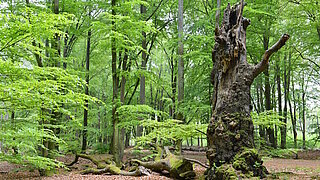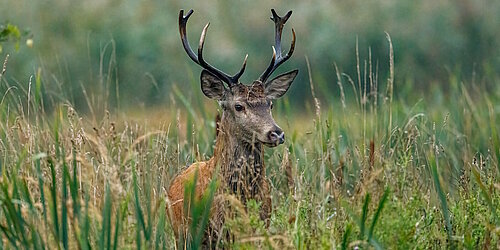Wilderness and protected areas
Providing more space for nature is good for biodiversity, climate protection and adaptation to the impacts of climate change. The Centre of Competence for Nature-based Climate Action (KNK) provides advice about measures that can be used to achieve this in Germany.
Whether on land or in water: when nature is allowed to develop according to its own rules, or when near-natural habitats are conserved or restored, biodiversity flourishes. Near-natural forests, wetlands or grasslands are also effective carbon sinks and thus contribute to nature-based climate action.
The state of play for wilderness and protected areas in Germany
Protected areas are one of the most important instruments for nature conservation. They make a direct contribution to conserving species and their habitats. There are various categories of protected area, which differ in terms of their conservation purpose, conservation targets and the restrictions that these goals place on their use. The most important categories are nature reserves, national parks, national natural monuments, biosphere reserves, landscape protection areas and nature parks, as well as Natura 2000 sites.
Areas that are largely unaffected by human activity now exist in Germany only in fragments. Currently, only about 0.6% of Germany’s territory is secured as large-scale wilderness. Moreover, not all habitats within protected areas are in a favourable conservation status.
What action can be taken to strengthen wilderness and protected areas?
The aim is to safeguard valuable habitats by providing sufficiently large protected areas that are also interconnected. Wilderness areas in Germany are therefore to be expanded. The goal of the National Biodiversity Strategy 2030 (NBS) is to secure at least two percent of Germany’s territory for large-scale wilderness development by 2030. Smaller wilderness areas also play a role in linking habitats and contribute to nature-based climate action.
The KlimaWildnis funding programme is designed to complement the Wilderness Fund by also promoting the purchase of smaller areas. Local KlimaWildnis ambassadors will promote wilderness and the goals of nature-based climate action in their regions. The KlimaWildnisZentrale serves as the central point of contact for the KlimaWildnis ambassadors and coordinates activities in the field of wilderness conservation. The Centre of Competence for Nature-based Climate Action will support the development of these local structures and provide information about funding opportunities.
Mehr erfahren
Funding calls in the field of action
KlimaWildnis - more wilderness in Germany

Copyright: AdobeStock / dieter76
The Federal Ministry for the Environment promotes the development and protection of KlimaWildnis areas, i.e. smaller areas with their own dynamic development, as well as the recruitment of KlimaWildnis ambassadors.
